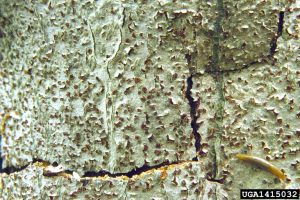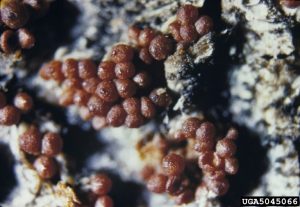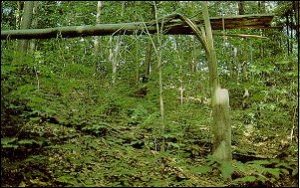Summary
Beech bark disease poses an enormous threat to the American Beech, and is widespread in the eastern United States and Canada. It is caused by two invasive species: the beech scale insect, as well as a fungus, most commonly the Nectria coccinea species. Beech scale was first introduced into Nova Scotia in 1890. It later spread throughout much of the United States and Canada, causing beech bark disease to develop in much of these regions. The disease occurs when the bark of a tree is initially attacked by the beech scale insect, and is then ultimately destroyed by the fungus.
Stages of Beech Bark Disease
Beech bark disease can take from three to six years to develop after beech scale invades the forest. The disease develops in three stages: the advancing front, the killing front, and the aftermath zone. During the advancing front, the tree becomes infested by the beech scale insect. During this stage, the beech scale damages the tree's bark. The following stage is known as the killing front, which occurs when the Nectria fungus infects trees through the damaged bark caused by the beech scale insect. This typically occurs a few years after beech scale invades the forest. Finally, the aftermath zone occurs when trees die. Large trees might remain in the forest if they are resistant to the beech scale and/or Nectria fungus.
Visual Signs
There are several visual signs that beech bark disease is present in a forest. Blotches of a white, waxy covering on a tree's trunk may indicate the infestation of the beech scale insect. This is caused by a white wooly wax that covers the insect’s body. After beech scale becomes established, beech bark disease is almost inevitable. Later indicators of a Nectria infection include red or brownish spots on the bark of a tree, in addition to yellow foliage. The red or brownish spots represent the Nectria itself on the tree. During the aftermath zone, trees may be broken by strong winds. This is known as beech snap.
Impacts on the Ecosystem
The ecosystems of forests are strongly impacted by this disease, as a multitude of birds and animals rely on the American Beech species for food and habitat. Black bears, grey squirrels, chipmunks, turkeys, and deer are just a few examples of animals that feed on beech nuts. Additionally, several species of hawks and raptors nest in beech trees.
References
Houston, D. R. (1998). Beech bark disease. Retrieved April 3, 2017, from https://www.nrs.fs.fed.us/pubs/jrnl/1998/1998_exotic-pests-papers/houston_1998-exoticpests.pdf
Houston, D. R., & O'Brien, J. T. (1983). Beech bark disease. Retrieved April 3, 2017, from U.S. Department of Agriculture Forest Service website: https://www.na.fs.fed.us/spfo/pubs/fidls/beechbark/fidl-beech.htm
McCullough, D. G., Heyd, R. L., & O'Brian, J. G. (2005, March). Biology and management of beech bark disease. Retrieved April 3, 2017, from http://msue.anr.msu.edu/uploads/files/e2746.pdf
Percival, G. C. (n.d.). Plant health care program. Retrieved April 3, 2017, from https://www.bartlett.com/resources/Beech-Bark-Disease_UK.pdf
Image Credits
A beech tree with beech bark disease: "beech bark disease (Nectria coccinea)" by Andrej Kunca, National Forest Centre - Slovakia, Bugwood.org, licensed under CC BY-NC 3.0
Beech scale insect: "Beech scale nymph" by the U.S. Department of Agriculture Forest Service, licensed under the public domain
A tree infected by the Nectria coccinea fungus: "Nectria coccinea fruiting bodies" by Joseph O'Brien, USDA Forest Service, Bugwood.org, licensed under CC BY 3.0
An example of beech snap: "Beech snap" by U.S. Department of Agriculture Forest Service, licensed under the public domain



